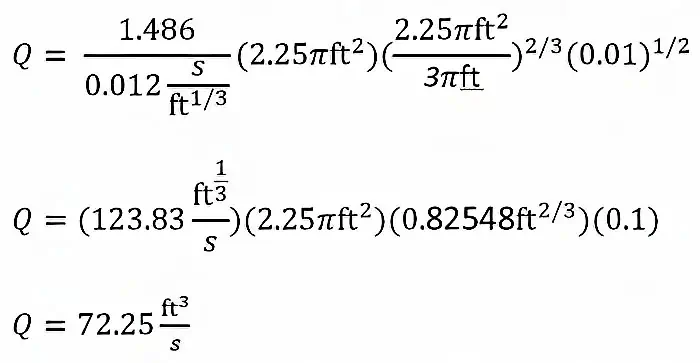In this article, (and video above), we calculate the capacity of a concrete stormwater pipe that forms part of the Fluid Mechanics section of the FE Exam.
Question:
A concrete stormwater pipe is 500 feet long and has a pipe diameter of 36 inches. The inlet elevation is 165 feet and the outlet elevation is 160 feet. The Manning roughness coefficient, assumed to be constant with depth of flow, is 0.012.During heavy rainfalls, the stormwater pipe flows full with no surcharge.
During heavy rainfalls, the capacity of the stormwater pipe is most nearly:
Explanation:
We can rely on the FE guidebook for this problem. We can search for Manning’s equation, which is located within the Fluid Mechanics section. The equation is provided for both discharge (rate of volume) and velocity (speed).
We note that the answers are given in units of discharge, so we will want to use the top equation.
Referring to the original problem: “A … pipe is 500 feet long and has a … diameter of 36 inches. The inlet elevation is 165 feet and the outlet elevation is 160 feet. The Manning roughness coefficient … is 0.012 … the pipe flows full with no surcharge.” We can identify the following variables:
Now that we have our variables completely substituted, we solve for Q, the discharge.
Answer:
The Correct Answer is C
This Episode Is Brought to You by PPI

I hope you found this week’s FE Environmental engineering exam prep question helpful. In upcoming articles, I will answer more FE Exam questions and run through more practice problems. We publish videos bi-weekly on our Pass the FE Exam YouTube Channel. Be sure to visit our page here and click the subscribe button as you’ll get expert tips and tricks – to ensure your best success – that you can’t get anywhere else. Believe me, you won’t want to miss a single video.
Lastly, I encourage you to ask questions in the comments of the videos or here on this page and I’ll read and respond to them in future videos. So, if there’s a specific topic you want me to cover or answer, we have you covered.
I’ll see you next week.
Anthony Fasano, P.E.
Engineering Management Institute
Author of Engineer Your Own Success






Leave a Reply